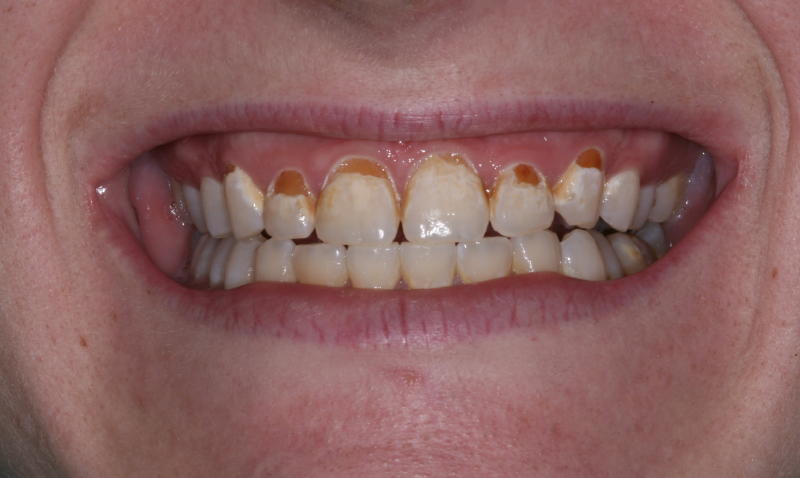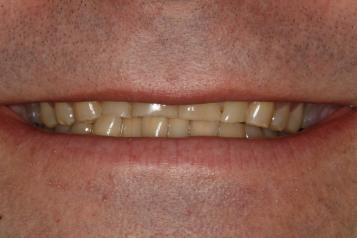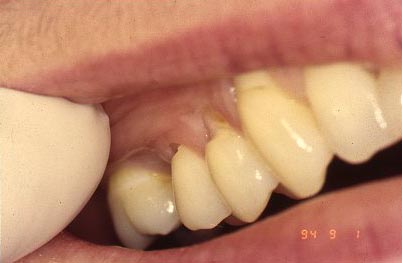Introduction
We will see six examples of oral problems as they often appear in the dental office in this Chapter. Answers to many questions about these issues may also be found under the FAQ – The Way In heading above.
- Pain and Sensitivity
- Gum Diseases
- Grinding teeth
- Joint Disorders
- Missing Teeth
- Systemic Disease and the Mouth
We have already mentioned in the preface the magnitude of personal and total dental care expenditures in the U.S. in comparison with the complexity of that care. But, being convinced that dental care deserves more careful attention, and relating this to YOUR personal dental needs are two different things.
In this chapter will be briefly described some of the most commonly encountered dental problems, for children, teens, middle aged adults and seniors. Some of the pictures or descriptions may seem familiar from your own personal experience. Dentists encounter all of the situations described in this chapter on a daily basis, and more often or not the patient is not aware of these conditions.
And, some oral symptoms are caused by Systemic Disorders.
Awareness can save a lot of time, effort, pain and money. The remainder of this site is devoted to making you aware. What is covered in this section in a short paragraph will have a chapter devoted to it later, describing the disease or problem, and then another chapter discussing possible cures or solutions. For now, we will just look at some illustrative examples.
Oral Problems: Decay, Sensitivity and Pain
Are your teeth sensitive to cold, hot or pressure? How long does the pain last, seconds or minutes? The nature of the infection and whether it is reversible depends on the answer to these questions. Pain can be merely a sensitivity to cold due to gum recession from common gum disease, or it can signify the inevitable need for a root canal. If pain in a front tooth is accompanied by swelling under the eye, then there is even a risk of loss of LIFE if left untreated! Visit Chapter IV.1 for more on Pain.
Hang out around any dental office that specializes in children and you’ll see lots of kids with bottle-mouth syndrome. The mouth needs to bathe the teeth in saliva to inactivate the bacteria that cause decay. When the teeth are being bathed for long periods of time, hours on end, with juice, milk, formula or even mother’s milk, then the decay process can be rampant. There is nothing sadder than seeing a 2 year old that must have many of his baby teeth taken out because the decay is too far advanced. When this happens there is nothing to guide the permanent teeth into place and even if braces are done later, the damage to the self-image by the age of 10 may never be reversed. Visit Chapter V.19 for more on Kids.
Teens these days often have few if any fillings, primarily due to fluoride exposure. There are exceptions – the occasional 13 year old that must have a root canal on a permanent molar which then must last for another 70 years! Late teens may start to need fillings on the surfaces between adjacent teeth. These teeth may be weakened substantially by the restorative process if the decay isn’t detected early when the fillings can be conservative in size. See Chapter V.2 for fillings on back teeth.
Teen years typically begin the use of tobacco and other drugs. Some of these have very specific effects on the teeth, and methamphetamine use, in particular, produces a definite pattern of decay and tooth loss which will be described later, but which can be devastating.
Middle age is when the restored teeth start to break. Popcorn nibs are still a likely culprit – especially during exciting movies! The brain is extremely good at avoiding trauma to the teeth, but popcorn can produce an unexpected and damaging impact. See Chapter V.6 on crowns.
The older age group has decay due most often to exposure of the tooth roots, which are softer than tooth enamel. Decay between the exposed roots of a single tooth can present an impossible challenge to the dentist. Another cause of dental decay in seniors is the more frequent use of prescription drugs which cause dry mouth. A dry mouth will generally lead to severe decay problems because the immune components of the saliva are missing. Head or neck radiation therapy is also a major culprit, again, because of a dry mouth as the salivary glands are potentially harmed. The picture below illustrates dry mouth effects. As you can imagine, the manner in which these areas are repaired has a great bearing on the future of these teeth, especially if the patient is in the younger side of the age range, and would like to keep the teeth for decades.

Oral Problems: Gum Diseases – Periodontitis and Gingivitis
Each tooth is connected to the body by microscopic ligaments. Some of these are anchored to bone and some are anchored in the gum tissue. Also, there is a layer of special cells in the gum tissue which adhere to the tooth. When this attachment is damaged due to bacterial infection, both the bone support of the tooth and the gum attachments recede. This leads to deep spaces or pockets around the tooth, where the attachment should be. These spaces are ideal locations for colonization of more damaging bacteria. Teeth with very deep pockets will be very difficult to save.
While a small degree of gum disease leading to loss of attachment is common by the age of 30, if not arrested by specific measures, it will progress until there is NO attachment and the tooth is lost. Alternatively, attachment is lost until parts of the tooth are exposed that, when decayed, are impossible to adequately restore.
INFLAMMATION is a key element of gum disease. If you have inflammation – red, swollen, painful, gums which no longer have their natural shape – but you do NOT yet have any loss of attachment, this is gingivitis. When there is inflammation AND attachment loss, this is periodontitis, periodontal disease. If you have NO inflammation, whether or not you have attachment loss, your gums are healthy! Visit Chapter IV.4 for diagnosis of periodontitis, and Chapter V.12 for the treatment options.
Oral Problems: Grinding and Overstressing Teeth
Grinding the teeth, especially at night, is very common. It may be more so in “Type A” personalities, but for many it is a favorite pass-time. Actually, one has to think that if it weren’t for the self-sacrifice of the teeth, ulcers may have been inevitable. Medications are available now that work well for ulcers, but not for tooth grinding.
Tooth Grinding is treated in detail in Chapter III.4.

The most obvious consequence of tooth grinding is flat teeth. All of those nice cusps are worn off. This leads to difficulty in chewing food – that steak just isn’t the same anymore! In extreme cases, which are not unusual, grinding wears the teeth so much that vital parts can be exposed, or that the teeth are considerably weakened and eventually break. As the teeth wear out the chin and the nose start to get closer together, changing physical appearance dramatically, although slowly. When the bite collapses it is also common to have the lower front teeth actually bite into the palate upon closure. Situations like this can only be remedied by rebuilding every tooth in the mouth!
Grinding the teeth also leads to front teeth which are flat at the edges, as seen in the picture above. This is not the way they were meant to be, and the appearance is considerably different from someone younger with nice rounded edges. In other words, flat teeth make a person look OLD. For some people, mostly men, who start grinding in their teens, they can look considerably older than their age by the time they are 40. This can be a disadvantage in many of life’s situations. Visit Chapter V.15 for more on collapsed bite and full mouth reconstruction.
The clenching habit does not involve grinding of the teeth over each other, but biting and squeezing. This is done largely to relieve stress. Often the sore muscles that result are a tell-tale sign. Sometimes the muscles even become over-developed because of this exercise and, again, the physical appearance of the person is altered. One of the most common results of grinding and clenching is the notch-shaped damage to the outside of the teeth due to frequent BENDING of the tooth under excess load. The picture below graphically illustrates this phenomenon. Visit Chapter III.5 for more discussion of this type of lesion.

Oral Problems: TMJ (Temporomandibular Joint) Disorders
The joints which hinge the jaw are the most complicated joints in the body. They have a complex hinging-sliding action which is unique in human anatomy. When the join is in the place where it hinges most comfortably, closure of the mouth should lead to the teeth meeting evenly and perfectly. Often the brain has to compensate when this is not achieved mechanically. A variety of muscles slide the joints while the jaw is closing in order to keep interfering tooth cusps from hitting. Many dentists feel that this can lead to joint disorder, or to facial pain due to muscle overuse. Stress is certainly an important factor in combination with a bite that is pathologic (i.e. causing symptoms).
The joint can have defects that arise from other causes. There is a disc in the joint separating the ball part of the jaw from the socket near the ears. This disc can slip out of place easily in some people. The popping or clicking that is heard is an indication of this disorder. If the problem progresses, permanent damage to the disc can result (listen for a grinding sound in the joint), or the jaw can even LOCK OPEN from time to time. Chronic pain is often accompanying.
Naturally, arthritis can also affect the TMJ, and trauma is a frequent cause of pain and damage in these joints as well.
The diagnosis of TMJ disorder is one of the more difficult and controversial areas of dentistry today. Visit Chapter III.6 for more discussion on this subject.
Oral Problems: Missing Teeth
A missing tooth, whether due to trauma, decay, or gum disease, needs to be replaced with a bridge, partial denture, or an implant. If the tooth is not replaced, the other teeth naturally move to fill in the space. The opposing tooth will erupt further and the adjacent teeth may lean into the space. The bite is thrown off considerably, producing in the susceptible person a variety of disorders (again, stress plays a role). A missing tooth can also cause surfaces of other teeth to be exposed which would not otherwise happen. Exposed surfaces are vulnerable. To make matters worse, the longer it is missing, the more difficult it is to replace due to the poor position of the neighboring teeth and the loss of bone in that area. Visit Chapter III.9 for more on missing teeth, and Chapter V.13 on replacement of missing teeth.
Oral Problems: The A,B,C, and D of Systemic Disorders which affect the Mouth
A. AIDS. There are several signs and symptoms in the mouth that are among the earliest indications of AIDS. In particular, there is a form of cancer that is common in AIDS victims, but there is also a tendency to form a whitish, hairy border to the tongue. See Chapter IV.2 for a discussion of soft-tissue lesions which the dentist will watch for.
B. Birth Abnormalities. The well known disorders resulting in cleft palates are often treated by dentists in order to improve the patient’s ability to speak correctly and breathe well. This is particularly true for children so that their development is not abnormal. But there are also some inherited defects of the teeth, or teeth and bones. Often these lead to a breakdown of the structure of the teeth so that by the time a child is 4 years old, all of the baby teeth are flattened to the gum-line. The situation can have devastating repercussions for child development. This author has treated a mother and her two boys for such a disorder. This has included making a full set of dentures for the 5-year old child. Interestingly, the mother’s grandfather and great-grandmother also had the same problem. While these types of disorders are rare, they occur often enough for dentists to develop creative plans for management. See Chapter V.19 for more on dentistry for kids, including an illustration of this treatment.
C. Cancer. There are several kinds of cancer which show up specifically in the mouth, thus the importance of periodic oral cancer screenings. Also, some cancers in the area of the mouth, when removed, leave physical defects that a dentist must repair to permit normal function. It is not unusual to remove a large portion of the palate in certain cases, thus resulting in a large opening from the mouth up through where the sinuses were, into the nasal cavity. A replacement device made from plastic is needed in these cases. Also, radiation therapy for cancer in the head and neck region will cause an alteration in the salivary flow as discussed earlier. It is important to realize that this decay problem can often be prevented or arrested if the appropriate communication between the patient’s physician and dentist is made. So often the teeth are considered too late, only to result in their loss. The recovery from cancer treatment is only that much more difficult when the patient also must get used to new dentures at the same time. Achieving the appropriate dietary intake is then especially challenging.
D. Drugs. Both prescription and recreational drugs can have a major impact on the mouth. Mainly, the prescription drugs fall into two categories; those which make the mouth dry (mentioned earlier), and those which cause the gum tissues to enlarge. The enlargement must be removed surgically as long as the patient takes these drugs.
The situation with regard to recreational drugs, particularly methamphetamine (speed …) will be described in more detail later – but this drug can be quite devastating in the mouth. I have had many patients who have abused methamphetamine in the past and performed dental evaluations on over 100 former users. While the devastation can be real, it can also be avoided if one takes reasonable care of their teeth on a daily basis. See Chapter III.9 for more on this subject.